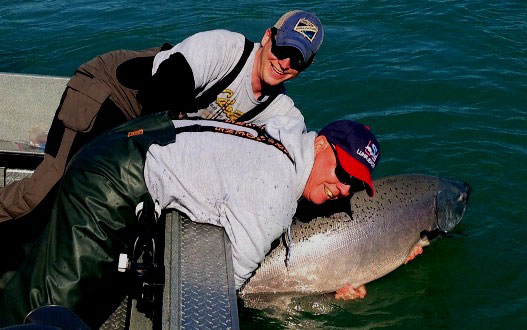
Longtime Fish Alaska contributing editor and columnist, and noted Kenai and Kasilof river guide Greg Brush penned this from-the-heart-and-brain post on the conservation of Kenai River kings. Greg’s EZ Limit Guide Service has gone to 100% catch-and-release fishing on Kenai kings, putting his money exactly where his mouth is.
Kenai king season is over, but our woes are far from gone. Point in fact: Last year, despite a new late-run escapement goal—a number lower than any return ever documented by the Alaska Department of Fish and Game—we still barely met our minimum escapement goal on the Kenai.
There are myriad reasons for this, but the bottom line is mismanagement in the form of ADF&G allowing too much harvest. In past years, I harvested too many Kenai kings. So did my clients. Most likely, you did too! Local commercial fisherman, set-netters and drifters alike, all killed too many Kenai kings, as did the Kodiak intercept fishery. And in recent years, we have found that the Bristol Bay pollock fishery has done its share of damage, to say the least.
Can you or I control these fisheries? Can we control fellow sport anglers? Clearly the answer is no, but we can control our own behavior, make a statement and lead by example. We can choose catch-and-release of these genetically unique, wild, highly limited Chinook. We all know that Kenai kings are not a species of abundance, such as sockeye, so why do we catch, kill and fill our freezer with them when there are other readily available salmon? Ask yourself this: as a sport angler, would you kill a wild steelhead for the table? How about a 30-inch wild rainbow trout? My bet is that your answer is a resounding NO! Those fish are special!
Anyone who fishes kings on the Kenai River can attest to the fact that there are less fish, and fewer big fish, than yesteryear. ADF&G’s own data shows that giant five-ocean (7-year-old) late-run Kenai kings are in serious decline; whereas five-ocean Chinook (70-plus-pound fish) used to make up about 3% of the run, the number now hovers at less than one percent. And look at the early run: Where we used to start catching fish reliably in mid-May (Les Anderson’s world record was caught on May 17) nobody even fishes that early now, because that segment of the early run is gone. Mid-June, historic peak of the early run, isn’t much better—a boatload of four anglers feels pretty lucky if they get a strike or two. And in July…well, if you fish hard and know your stuff, you’ll eventually get a strike. Is that your idea of a healthy, successful king salmon fishery?
It is high time to take action. Stop pointing fingers at the other user groups, clean your own house and do what’s right; elevate the Kenai king to the status these special fish merit and treat them with the respect they deserves. Hook, fight, photograph…and let your catch go to pass on its unique genes. There are other fish, even other kings (just up the road in the Kasilof, for instance), for the freezer.
Catch-and-release fishing works. It has protected hundreds of species and restored entire fisheries, including populations of tarpon, snook, marlin, permit…and steelhead and wild rainbows (take a quick peek at the recent history of Lake Creek and Talachulitna rainbows if you’d like a primer on how it’s worked in Alaska). Don’t get caught-up in the naysayers’ notion that C&R is somehow inherently evil; ADF&G did a study many years ago that showed C&R mortality on Kenai kings at 7-8%, but that was with bait, multiple hooks and before our “can’t remove the fish from the water” regulation. I contend that “modern C&R” on Kenai kings results in a 1-2% mortality rate, if not lower. This summer, my guests and I practiced total C&R on all our Kenai kings and I can proudly say that my boat didn’t have one fatally hooked king! Ask yourself this… would I rather support C&R where perhaps one out of a hundred kings caught dies, or practice “catch and keep” fishing where 100% of these genetically unique salmon caught die?
Don’t get caught up in ADF&G’s reluctance to embrace catch-and-release, or buy their ridiculous excuses and convoluted scientific theories. Yes, studies are necessary, as is sound science, but blaming the decline of Kenai kings on “a period of low abundance” or mysterious “ocean conditions” is simply a cop-out. Point out the past few years of sockeye returns, or the remarkable return of big, healthy Kenai River coho that we had this fall; they sure didn’t struggle with an unhealthy ocean!
Do your small part. And be sure to demand honesty and accountability from our Fishery Managers at this coming winter’s Board of Fish meetings.
